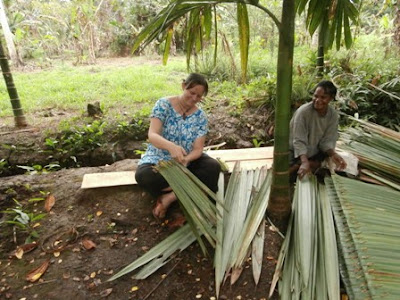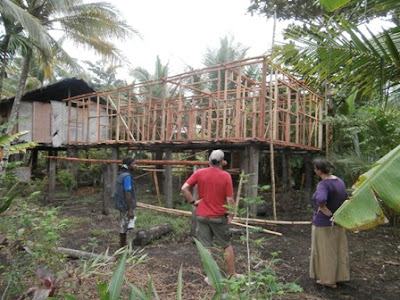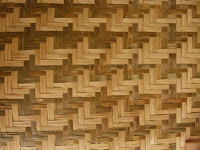Let’s go on a guided tour of my village house.
In February there was a block of land and an idea.
 |
| On the empty land with Sampson, who is a
literacy teacher, translator, my neighbour, my village brother and the one who was in charge of building my house. |
I didn’t expect there to be a house on that land when I
returned in April, but it was well under way.
Over
the next five weeks, it was finished!
There
were two big working bees involved. The first was the biri party, when about 40
women from Ubuo (my village) and Goiravi (a 15 minute walk away) came to stitch
thatch for the roof from nipa palm leaves or to cook food for the workers.
About 30 men and boys turned up to finish the roof frame and attach the thatch.
 |
| Expert biri stitchers |
 |
| Novice biri stitcher, but the centre of
attention for giving it a try. I completed three lengths of biri |
 |
| The team doing framing and putting the biri up. They’ve already completed the far side of the house. |
When the decision was made to dedicate my house on the
coming Sunday, my house was far from complete.
 |
Thursday, when the
dedication is to be on Sunday.
No end walls,no internal wall, holes in the floor, an open patch in the roof…! |
Thankfully the next working bee was on the Friday, when a work team came from Kapuna hospital to
install my toilets, wash place and rain water tanks. Due to technical
difficulties, the tanks did not get done that day. The team arrived in the
morning, offloaded their supplies and worked hard all day. Others from the
community turned up and an amazing amount was achieved.
 |
| Cleaning up ready for the working bee to start |
 |
| The Kapuna team turns up and offloads supplies… |
 |
| …including the ark of the covenant?! No, just a big, heavy box full of tools.... |
 |
| …including power tools, so they brought a generator too. |
 |
| Later in the day, the end wall is finished, the front stairs are in place and decorative railings are being installed. |
 |
Inside, the Kapuna
crew install
composting toilets and a wash place. |
A lot more work happened on the Saturday, and on Sunday we
really were ready to dedicate the new house. The land owner was the one who
gave me the key to the front door and said that he gave the land to the Kope
translation project.
 |
| Dedicating the house was quite the ceremony… |
… and of course was finished
with a feast.
Inside
my house I have three bedrooms (who of you will be first to visit?), a store
room, a bathroom, a kitchen space and my long open living area. There is also the
translation verandah, which is my attempt to have some sort of work/private
divide in the village. We’ll see how that goes!
 |
| Finished house looking towards the front door. The sawn timber is all off cuts from the local timber mill |
 |
| Finished house looking from another angle. The low bit is my translation veranda. The window up higher is my kitchen window. |
 |
| My bedroom, which is basically a mattress on the
floor under my mosquito net plus a small amount of hanging storage |
 |
| Standing in the front door looking at the
living space on the left and translation veranda on the right |
 |
| Looking back at the front door along the
translation verandah. Through the house windows is the living area. |
 |
| Some of the beautifully woven panels of wall inside my house. |







No comments:
Post a Comment